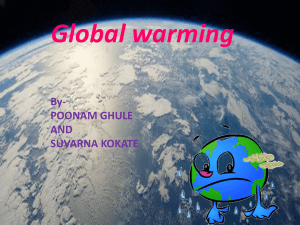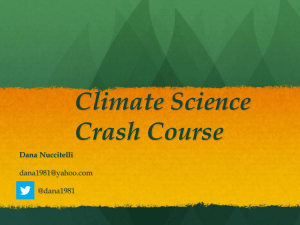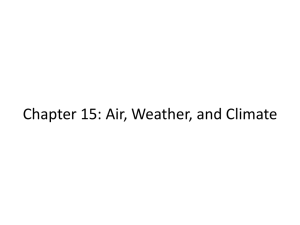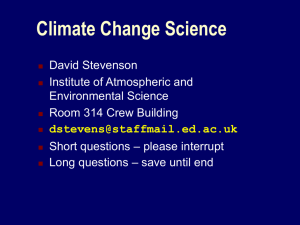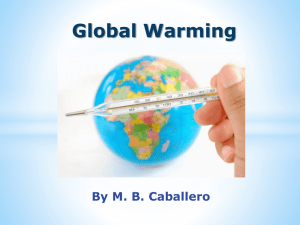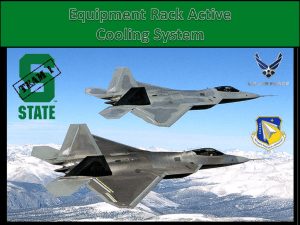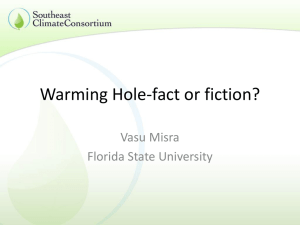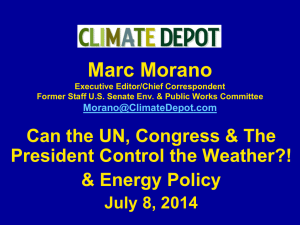PowerPoint - Climate Conferences
advertisement
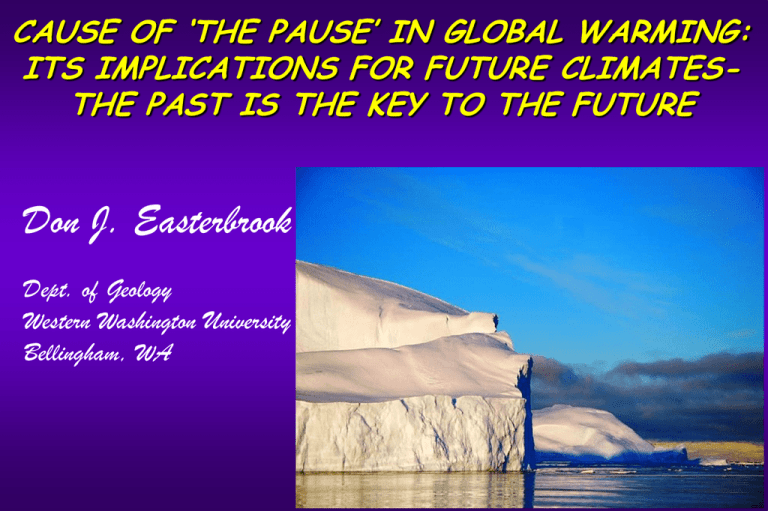
CAUSE OF ‘THE PAUSE’ IN GLOBAL WARMING: ITS IMPLICATIONS FOR FUTURE CLIMATESTHE PAST IS THE KEY TO THE FUTURE Don J. Easterbrook Dept. of Geology Western Washington University Bellingham, WA WARNING!!!! A LOT OF DATA IS COMING!!! What is ‘the pause’ ? The absence of global warming for the past ~18 years has become known as “the pause.” but, in fact, that is a bad term because it implies that the norm is continued warming and cooling is an anomaly. It has been characterized as the “biggest mystery in climate science,” but it is not a mystery at all—it’s been going on for millenia. Atmospheric CO2 increased only 0.004% during ‘global warming Previous ‘pauses’ Three warming periods since 1850 have been interrupted by cool periods (‘pauses’). 20 warming periods since 1480 have been interrupted by cool periods (‘pauses’) Warm/cool periods over the past 10,000 years Until the Little Ice Age began about 1300 AD, the climate had been 2½-5½ °F warmer than present for 8,500 years. Cause of the ‘warming pause’ Glacier fluctuations match the Pacific Decadal Oscillation (PDO) which matches global temperature Good correlation of PDO + AMO and Arctic mean temperatures and glaciers in the Alps GLACIER FLUCTUATIONS CLIMATE CHANGES PDO-AMO MODE CHANGES WHAT DRIVES PDO-AMO MODES? WHAT’S IN STORE FOR THE NEXT 30 YRS? Predicting future climates In order to predict where we are heading, we need to know where we’ve been. The past is the key to the future. Having established a well-defined pattern of warming and cooling, we can project that pattern into the future. Measuring climatic warming/cooling in the geologic past Historic temperature measurements Oxygen isotope ratios in deep ice cores. Advance glaciers. and retreat of Measurement temperatures of ocean Data in this presentation may be found in this volume PDO 1900-present Modified from http://jisao.washington.edu/pdo/ Pattern of repeated warm/cool PDOs DJE predictions in 2000 “Global warming is over“ (Easterbrook, 2000, 2010) “The current warm cycle should end in the next few years, and global warming should abate, rather than increase, in the coming decades.” (Easterbrook, 2000) “The current warm cycle should end soon and global temperatures should cool.” (Easterbrook, 2006 How cool will it get? 1, Like 1945-1977? 2. Like 1880-1915? 3. Like 1790-1820 Dalton Minimum? 4. Like 1650-1700 Maunder Minimum? How well is the 2000 cooling prediction doing? 5-year and 10 year cooling trends Winters in the US have been much cooler than usual in the past 15 years Summary A consistent pattern of global warming and cooling has occurred for hundreds (thousands) of years. The pattern of past global warming and cooling can be projected into the future as a basis for predicting climate changes. The pattern of global warming and cooling matches warm and cool periods of the PDO (Pacific Decadal Oscillation) and is clearly related to the PDO/AMO. Projection of past climate patterns into the future, combined with the PDO turning cold in 1999 led to 2000 predictions of cooler global climates in the next several decades. So far my 2000 prediction of global cooling is indeed happening. The cause of global warming and cooling Role of the sun in climate change Correlation of global temperature and 1. Sun spot number (SSN) 2. Iotal solar insolation (TSI) 3. Solar magnetism 4. Cosmic ray intensity 5. Production rate of 10Be. 6. Prodcution rate of 14C CET during the Maunder Sun spots and cool periods TSI and global temperature SSN and TSI Global cooling and TSI Solar magnetic flux Production rates of 14C and 10Be as a measure of past cosmic ray activituy 14N 7 14C6 +n= 14C 6 + 1H1 = 14N7 + - Production of 14C6 varies with the neutron flux, causing 14C6 age to differ from calendar age Comparison of 14C ages with ages of tree rings gives a measure of 14C production rates (and thus changes in cosmic radiation) 10Be is produced in the atmosphere by the cosmic ray spallation of oxygen and is also a function of cosmic ray flux. 10Be CET temperature and 10Be 10Be and SSN Both 10Be and 14C record increased cosmic activity Sun spots and cosmic rays Cosmic ray incidence increases with low sun spot numbers Temperature decreases with increase in cosmic rays Condensation produced by cosmic rays CONCLUSONS ‘Global warming’ began in 1978. ‘The pause’ is a period of no warming for the past 17 yrs 9 months. Temperatures for the past 10,000 yrs were 2½-5½°F warmer than present until 1500 yrs ago when we entered the LIA. Many period of warming that ended with cool periods have occurred in the past. Well-defined patterns of the PDO and global temperature projected into the future indicate 25-30 yrs of cooling. My 2000 prediction of 25-30 yrs of cooling has been confirmed by cooling in the past decade. The amount of cooling might be similar to the 1945-1977, 1890-1915, Dalton (17901820), or Maunder (1650-1700) cooling. Good correlation of SSN, TSI, solar magnetism, cosmic ray intensity, and production rates of 14C and 10Be and global temperature indicate causeand-effect relationships between them. The Maunder, Dalton, 1890-1915, and 1945-1977 cool periods were all characterized by low SSN, low TSI, low solar magnetism, and high production rates of 14C and 10Be. Increased cosmic radiation induces atmospheric condensation that could lead to increased cloudiness and cooler temperatures (Svensmark). The sun causes global warming and cooling, but the mechanism is not understood. Look for continued global cooling. Time will be the judge of whether or not these observations and conclusions are correct. Dogma is an impediment to the free exercise of thought. It paralyses the intelligence. Conclusions based upon preconceived ideas are valueless. It is only the open mind that really thinks. Patricia Wentworth, 1949 For data and information go to: Bing.com or Google.com and enter Don Easterbrook global warming
